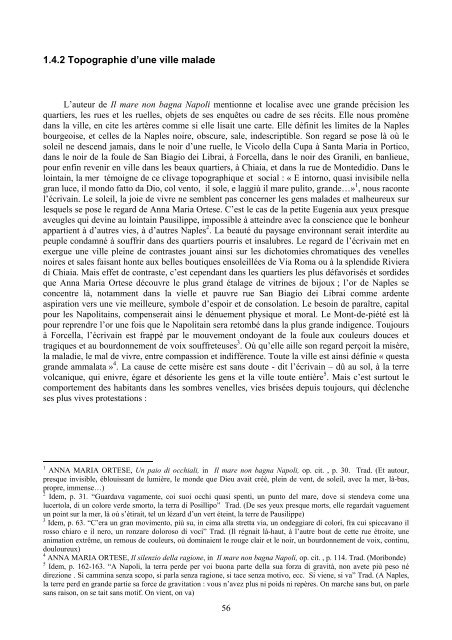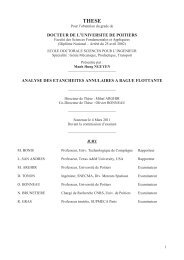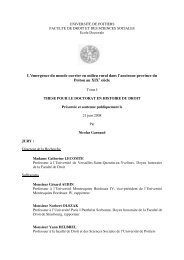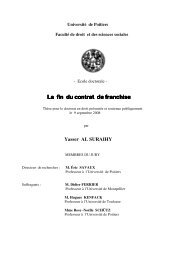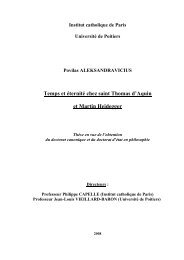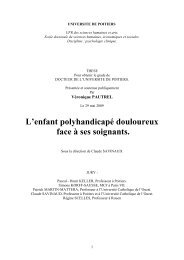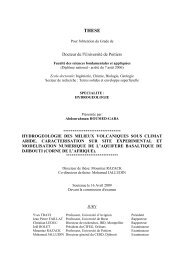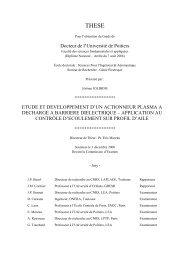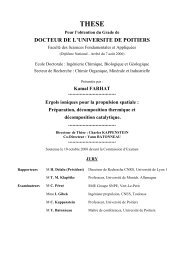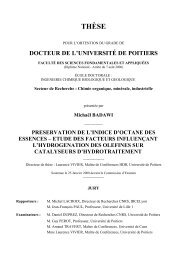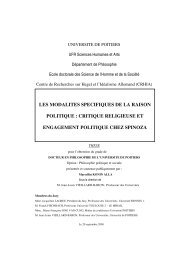Consulter le texte intégral de la thèse - Université de Poitiers
Consulter le texte intégral de la thèse - Université de Poitiers
Consulter le texte intégral de la thèse - Université de Poitiers
Create successful ePaper yourself
Turn your PDF publications into a flip-book with our unique Google optimized e-Paper software.
1.4.2 Topographie d’une vil<strong>le</strong> ma<strong>la</strong><strong>de</strong><br />
L’auteur <strong>de</strong> Il mare non bagna Napoli mentionne et localise avec une gran<strong>de</strong> précision <strong>le</strong>s<br />
quartiers, <strong>le</strong>s rues et <strong>le</strong>s ruel<strong>le</strong>s, objets <strong>de</strong> ses enquêtes ou cadre <strong>de</strong> ses récits. El<strong>le</strong> nous promène<br />
dans <strong>la</strong> vil<strong>le</strong>, en cite <strong>le</strong>s artères comme si el<strong>le</strong> lisait une carte. El<strong>le</strong> définit <strong>le</strong>s limites <strong>de</strong> <strong>la</strong> Nap<strong>le</strong>s<br />
bourgeoise, et cel<strong>le</strong>s <strong>de</strong> <strong>la</strong> Nap<strong>le</strong>s noire, obscure, sa<strong>le</strong>, in<strong>de</strong>scriptib<strong>le</strong>. Son regard se pose là où <strong>le</strong><br />
so<strong>le</strong>il ne <strong>de</strong>scend jamais, dans <strong>le</strong> noir d’une ruel<strong>le</strong>, <strong>le</strong> Vicolo <strong>de</strong>l<strong>la</strong> Cupa à Santa Maria in Portico,<br />
dans <strong>le</strong> noir <strong>de</strong> <strong>la</strong> fou<strong>le</strong> <strong>de</strong> San Biagio <strong>de</strong>i Librai, à Forcel<strong>la</strong>, dans <strong>le</strong> noir <strong>de</strong>s Granili, en banlieue,<br />
pour enfin revenir en vil<strong>le</strong> dans <strong>le</strong>s beaux quartiers, à Chiaia, et dans <strong>la</strong> rue <strong>de</strong> Montedidio. Dans <strong>le</strong><br />
lointain, <strong>la</strong> mer témoigne <strong>de</strong> ce clivage topographique et social : « E intorno, quasi invisibi<strong>le</strong> nel<strong>la</strong><br />
gran luce, il mondo fatto da Dio, col vento, il so<strong>le</strong>, e <strong>la</strong>ggiù il mare pulito, gran<strong>de</strong>…» 1 , nous raconte<br />
l’écrivain. Le so<strong>le</strong>il, <strong>la</strong> joie <strong>de</strong> vivre ne semb<strong>le</strong>nt pas concerner <strong>le</strong>s gens ma<strong>la</strong><strong>de</strong>s et malheureux sur<br />
<strong>le</strong>squels se pose <strong>le</strong> regard <strong>de</strong> Anna Maria Ortese. C’est <strong>le</strong> cas <strong>de</strong> <strong>la</strong> petite Eugenia aux yeux presque<br />
aveug<strong>le</strong>s qui <strong>de</strong>vine au lointain Pausilippe, impossib<strong>le</strong> à atteindre avec <strong>la</strong> conscience que <strong>le</strong> bonheur<br />
appartient à d’autres vies, à d’autres Nap<strong>le</strong>s 2 . La beauté du paysage environnant serait interdite au<br />
peup<strong>le</strong> condamné à souffrir dans <strong>de</strong>s quartiers pourris et insalubres. Le regard <strong>de</strong> l’écrivain met en<br />
exergue une vil<strong>le</strong> p<strong>le</strong>ine <strong>de</strong> contrastes jouant ainsi sur <strong>le</strong>s dichotomies chromatiques <strong>de</strong>s venel<strong>le</strong>s<br />
noires et sa<strong>le</strong>s faisant honte aux bel<strong>le</strong>s boutiques enso<strong>le</strong>illées <strong>de</strong> Via Roma ou à <strong>la</strong> sp<strong>le</strong>ndi<strong>de</strong> Riviera<br />
di Chiaia. Mais effet <strong>de</strong> contraste, c’est cependant dans <strong>le</strong>s quartiers <strong>le</strong>s plus défavorisés et sordi<strong>de</strong>s<br />
que Anna Maria Ortese découvre <strong>le</strong> plus grand éta<strong>la</strong>ge <strong>de</strong> vitrines <strong>de</strong> bijoux ; l’or <strong>de</strong> Nap<strong>le</strong>s se<br />
concentre là, notamment dans <strong>la</strong> viel<strong>le</strong> et pauvre rue San Biagio <strong>de</strong>i Librai comme ar<strong>de</strong>nte<br />
aspiration vers une vie meil<strong>le</strong>ure, symbo<strong>le</strong> d’espoir et <strong>de</strong> conso<strong>la</strong>tion. Le besoin <strong>de</strong> paraître, capital<br />
pour <strong>le</strong>s Napolitains, compenserait ainsi <strong>le</strong> dénuement physique et moral. Le Mont-<strong>de</strong>-piété est là<br />
pour reprendre l’or une fois que <strong>le</strong> Napolitain sera retombé dans <strong>la</strong> plus gran<strong>de</strong> indigence. Toujours<br />
à Forcel<strong>la</strong>, l’écrivain est frappé par <strong>le</strong> mouvement ondoyant <strong>de</strong> <strong>la</strong> fou<strong>le</strong> aux cou<strong>le</strong>urs douces et<br />
tragiques et au bourdonnement <strong>de</strong> voix souffreteuses 3 . Où qu’el<strong>le</strong> ail<strong>le</strong> son regard perçoit <strong>la</strong> misère,<br />
<strong>la</strong> ma<strong>la</strong>die, <strong>le</strong> mal <strong>de</strong> vivre, entre compassion et indifférence. Toute <strong>la</strong> vil<strong>le</strong> est ainsi définie « questa<br />
gran<strong>de</strong> amma<strong>la</strong>ta » 4 . La cause <strong>de</strong> cette misère est sans doute - dit l’écrivain – dû au sol, à <strong>la</strong> terre<br />
volcanique, qui enivre, égare et désoriente <strong>le</strong>s gens et <strong>la</strong> vil<strong>le</strong> toute entière 5 . Mais c’est surtout <strong>le</strong><br />
comportement <strong>de</strong>s habitants dans <strong>le</strong>s sombres venel<strong>le</strong>s, vies brisées <strong>de</strong>puis toujours, qui déc<strong>le</strong>nche<br />
ses plus vives protestations :<br />
1 ANNA MARIA ORTESE, Un paio di occhiali, in Il mare non bagna Napoli, op. cit. , p. 30. Trad. (Et autour,<br />
presque invisib<strong>le</strong>, éblouissant <strong>de</strong> lumière, <strong>le</strong> mon<strong>de</strong> que Dieu avait créé, p<strong>le</strong>in <strong>de</strong> vent, <strong>de</strong> so<strong>le</strong>il, avec <strong>la</strong> mer, là-bas,<br />
propre, immense…)<br />
2 I<strong>de</strong>m, p. 31. “Guardava vagamente, coi suoi occhi quasi spenti, un punto <strong>de</strong>l mare, dove si sten<strong>de</strong>va come una<br />
lucerto<strong>la</strong>, di un colore ver<strong>de</strong> smorto, <strong>la</strong> terra di Posillipo” Trad. (De ses yeux presque morts, el<strong>le</strong> regardait vaguement<br />
un point sur <strong>la</strong> mer, là où s’étirait, tel un lézard d’un vert éteint, <strong>la</strong> terre <strong>de</strong> Pausilippe)<br />
3 I<strong>de</strong>m, p. 63. “C’era un gran movimento, più su, in cima al<strong>la</strong> stretta via, un on<strong>de</strong>ggiare di colori, fra cui spiccavano il<br />
rosso chiaro e il nero, un ronzare doloroso di voci” Trad. (Il régnait là-haut, à l’autre bout <strong>de</strong> cette rue étroite, une<br />
animation extrême, un remous <strong>de</strong> cou<strong>le</strong>urs, où dominaient <strong>le</strong> rouge c<strong>la</strong>ir et <strong>le</strong> noir, un bourdonnement <strong>de</strong> voix, continu,<br />
douloureux)<br />
4 ANNA MARIA ORTESE, Il si<strong>le</strong>nzio <strong>de</strong>l<strong>la</strong> ragione, in Il mare non bagna Napoli, op. cit. , p. 114. Trad. (Moribon<strong>de</strong>)<br />
5 I<strong>de</strong>m, p. 162-163. “A Napoli, <strong>la</strong> terra per<strong>de</strong> per voi buona parte <strong>de</strong>l<strong>la</strong> sua forza di gravità, non avete più peso né<br />
direzione . Si cammina senza scopo, si par<strong>la</strong> senza ragione, si tace senza motivo, ecc. Si viene, si va” Trad. (A Nap<strong>le</strong>s,<br />
<strong>la</strong> terre perd en gran<strong>de</strong> partie sa force <strong>de</strong> gravitation : vous n’avez plus ni poids ni repères. On marche sans but, on par<strong>le</strong><br />
sans raison, on se tait sans motif. On vient, on va)<br />
56


